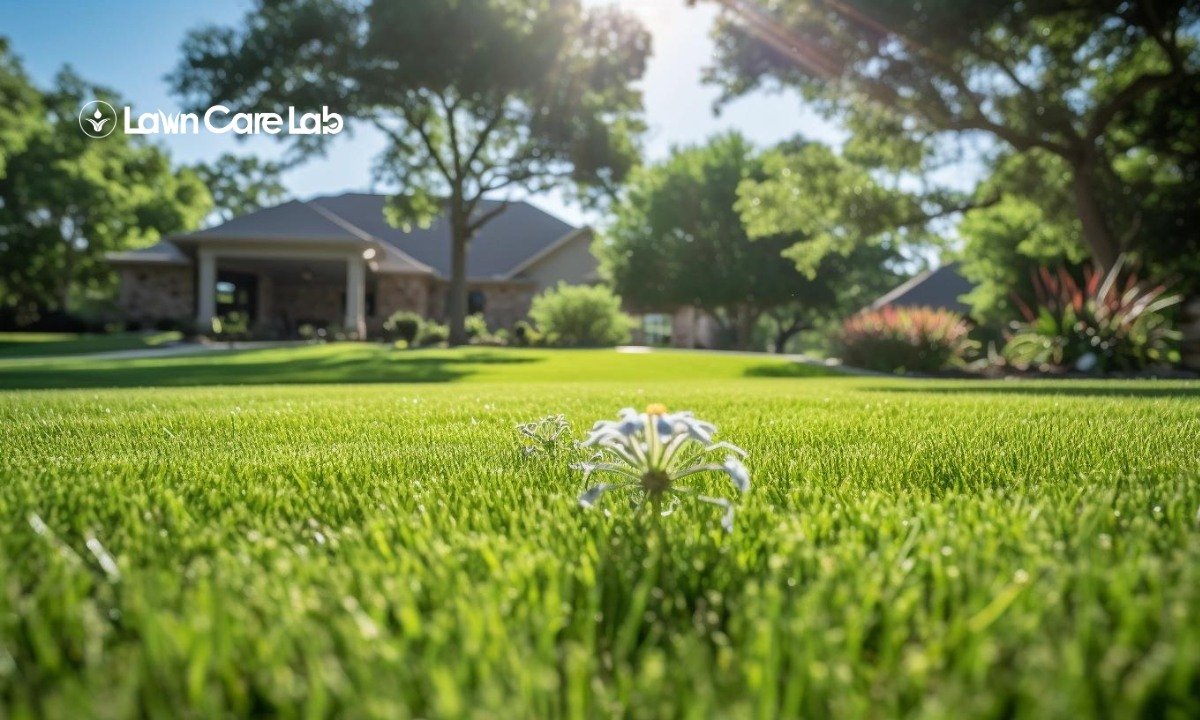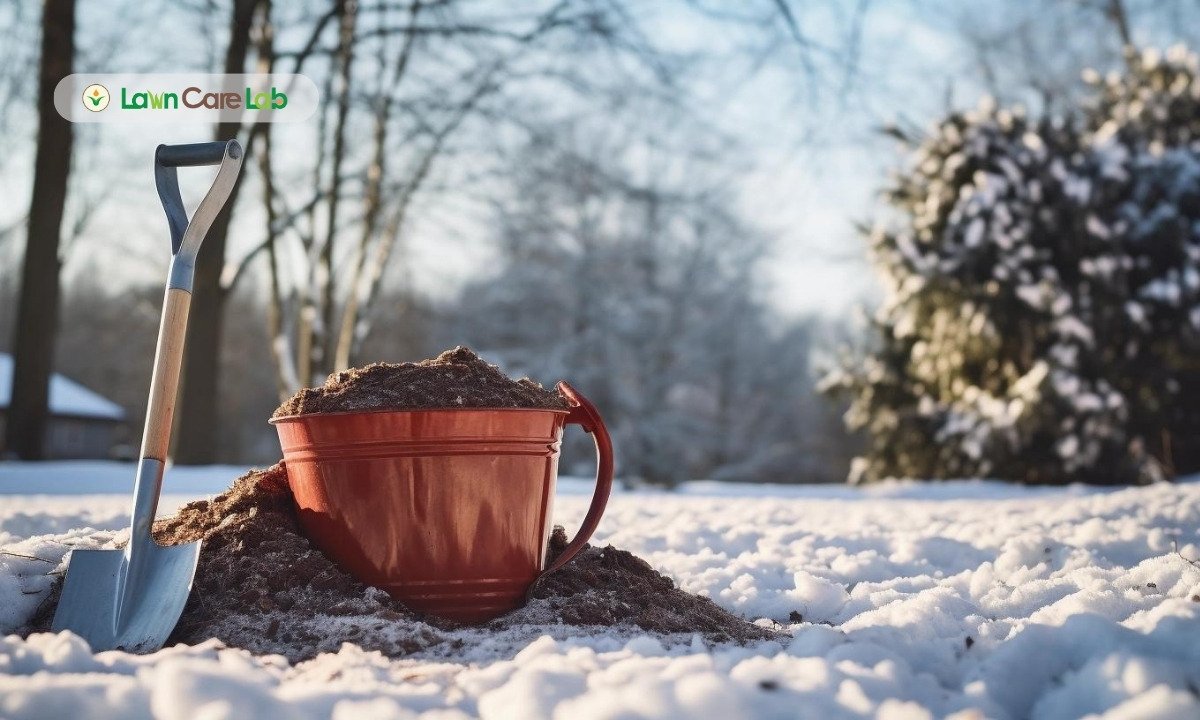Are you aware that most Mid-Atlantic homeowners find lawn care challenging? Don’t worry, you’re in good company. We’ve simplified the expert lawn care tips for Mid-Atlantic Yards.
This includes adjusting to seasonal changes, selecting suitable grass, and customizing your lawn care routine. Our expert advice will help you determine the right time and method to nourish your lawn.
Keen to have a vibrant, healthy lawn that’s the talk of the town? Let’s get started.
Table of Contents
Addressing the Region’s Variable Seasons and Climates
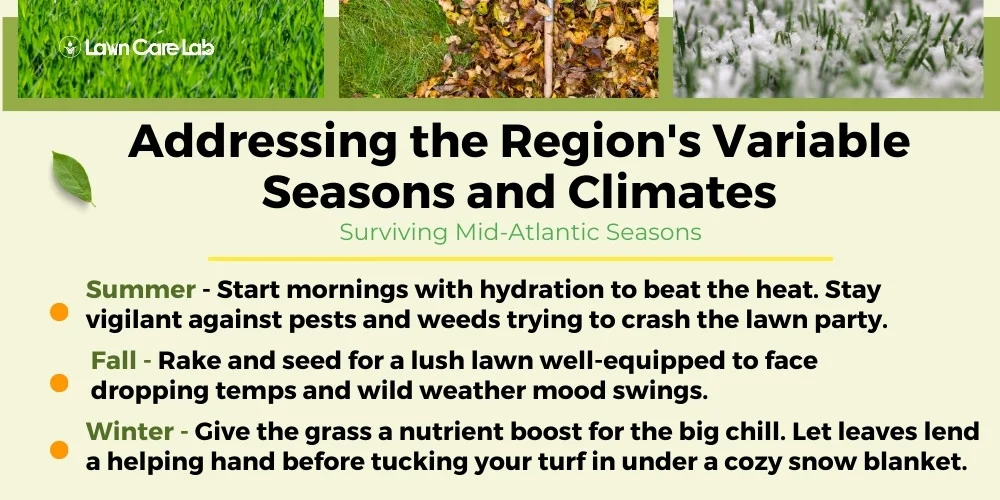
The Mid-Atlantic region presents a unique mix of weather conditions to navigate. From sweltering, sticky summers to the severe shift of transition seasons and winter’s biting chill, your lawn faces it all.
Planning for Hot, Humid Summers
Prepare for hot summers in the Mid-Atlantic by planning your lawn care strategy. Consistent summer upkeep is crucial for maintaining a healthy and green lawn.
Here’s some savvy advice to keep in mind:
- Set up a smart lawn watering system to hydrate in the morning to reduce evaporation.
- Stay on top of pest control, as those little critters can breed like crazy in the heat.
- Aerate your lawn to stop soil from getting too packed and to let water and nutrients seep ineffectively.
- Regularly trim your lawn, but keep it a bit on the high side to protect the soil and curb weed growth.
- Using pre-emergents can also effectively curb weeds.
Preparing for Transition Season Extremes
Preparing for unpredictable weather is important as fall arrives in the Mid-Atlantic region. Start by mowing and dethatching for better spring growth.
Remember to seed and nourish your cool-season grass when autumn arrives to weather the extremes. Stay on top of leaffall during these times to prevent your grass from suffocating.
Caring for Lawns in the Winter Cold
Living in the Mid-Atlantic region means enduring harsh winters. Your lawn needs extra care to survive. Here’s what to do:
- Apply a fungicide before the first snow to avoid snow mold.
- Do not step on the frozen grass – you might unintentionally harm it.
- Give your lawn a potassium boost in late autumn to increase its resistance to freezing.
- Don’t bother raking the leaves; they’re nature’s own insulator.
- Keep an eye on how your lawn is doing throughout the season.
- Yes, your lawn is sleeping, not dead, but it needs your help to wake up fit and green in the spring.
Now, let’s talk about picking the right grass for your local area.
Choosing Grass Types Suited to Local Areas
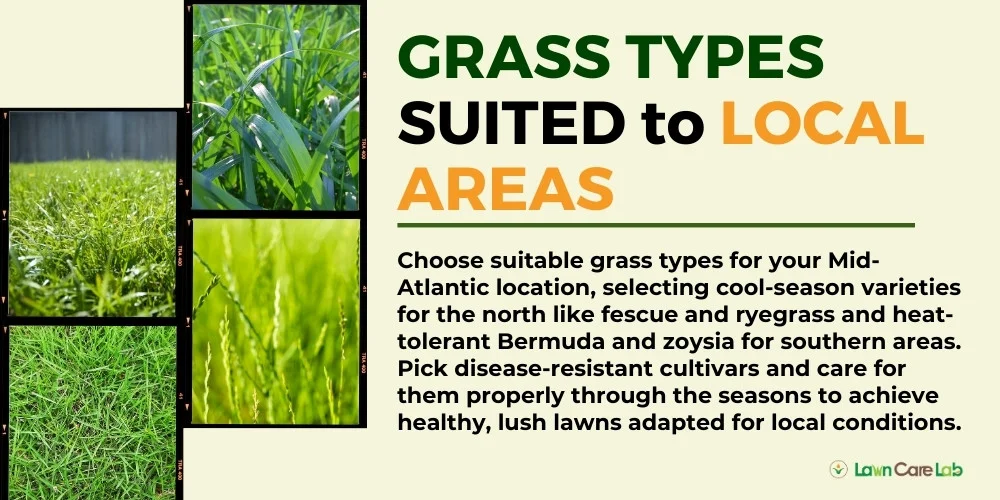
Picking the perfect grass for your Mid-Atlantic lawn depends on your location. Cool-season grasses thrive up north, while warm-season types are preferred down south.
And don’t forget, opting for grass that can stand up to local diseases can be the key to keeping your lawn lush and healthy.
Selecting Cool-Season Grasses for the North
Choose cool-season grasses like fescues, ryegrass, and bluegrass for a vibrant green lawn in the Northern Mid-Atlantic. They resist diseases and thrive through harsh winters.
To maintain a healthy lawn, prep the soil, use shade-tolerant grasses if needed, overseed regularly, and water and fertilize consistently.
A mix of different grass types can enhance your lawn’s visual appeal and resilience while making maintenance easier.
Opting for Warm-Season Varieties in the South
Choose heat and drought-resistant Bermuda and zoysia grass varieties for the southern Mid-Atlantic region. Opt for engineered types that can fight off common diseases in humid areas.
Caring for these grass types is simple. Water and feed during growth; rest in cooler months.
With this smart care strategy, achieve a lush green lawn suited to your local weather. It saves you time, energy, and resources in the long run.
Tailoring Mowing and Watering to Your Lawn’s Needs
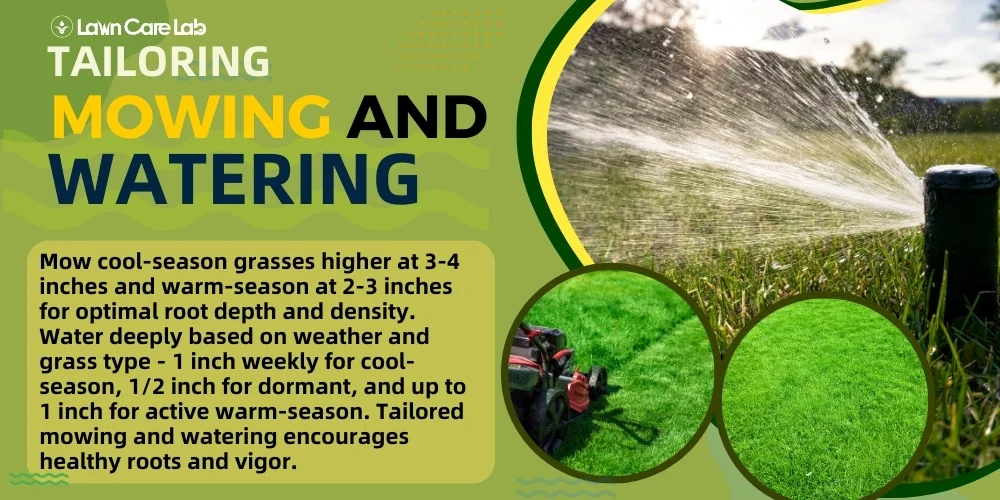
So, you’ve picked the perfect grass type for your yard in the mid-Atlantic region. Now comes the upkeep.
By mowing a bit higher, you’re promoting the growth of deeper roots, which in turn makes your lawn stronger and healthier.
Adapting watering habits to grass and local weather keeps lawn green.
Mowing High for Deep Root Growth
Mow your lawn based on the grass type for deep roots, weed control, and thickness. Precision mowing, avoiding scalping, and higher mowing can also help.
Keep the following in mind:
- Identify your grass: Cool-season types need a 3-4′ cut, while warm-season varieties prefer a 2-3′ cut.
- Be precise: The right blade height avoids scalping and boosts density.
- Mow higher: A taller cut encourages deeper roots.
- Keep weeds away: A thick lawn shades out weed growth.
- Boost root growth: Higher mowing helps roots delve deeper for water and nutrients.
Adjusting Watering for Climate and Grass Type
To water your lawn effectively, consider the weather and grass type. Use climate-smart techniques and know how much water your lawn needs.
Water your lawn deeply, but not too often, preferably in the morning. Cool-season grasses need around 1” of water per week, while warm-season varieties require 1/2” when dormant and up to 1” during growth spurts. Adjust watering frequency during hotter months to optimize hydration and minimize water wastage.
Innovate your lawn maintenance for a vibrant, healthy lawn year-round. Let’s discuss seasonal feeding.
Providing Proper Seasonal Lawn Feedings
So, you want your lawn to do more than get by, right? You want it to really shine. Well, the secret’s all in the feeding.
Feed your lawn in the right season based on the type of grass you have for a healthy and attractive look.
Fertilizing Cool-Season Grass in Fall
Getting your cool-season grass ready for winter involves a few key steps.
Fertilize your lawn in the fall to help it recover after winter and prevent nitrogen overload in summer.
Tips:
- Opt for a fertilizer high in potassium and phosphorus to boost root health.
- Time your application when the grass is in a growth phase, avoiding drought or heatwave conditions.
- Make sure to water well after fertilizing to aid nutrient absorption.
- Remember, too much of a good thing can be harmful, so don’t overdo the fertilizer.
- Consider a slow-release option that will nourish your lawn over time.
Next up, we’ll chat about how to care for warm-season grass in the middle of the summer.
Feeding Warm-Season Grass Mid-Summer
For warm-season grasses like Bermuda and Zoysia, avoid early spring feeding to prevent lawn diseases and weed control needs during peak growth periods in June and July.
Instead of watering and feeding in mid-summer, focus on maintaining a well-kept lawn to prevent pests and diseases.
Following Expert Lawn Care Tips for Mid-Atlantic Yards
Caring for a Mid-Atlantic lawn requires understanding the soil, turf diseases, and weed management tactics.
Here’s a quick guide to keep your lawn in top shape:
- Aerate your lawn regularly to help water and nutrients soak in.
- Tackle weeds promptly to avoid plant infestations.
- Diagnose and treat any lawn diseases to keep your yard robust.
- Consider lawn renovation if your yard needs a little extra TLC.
- Cater to your soil’s specific needs for best growth results.
Follow these pointers, and you’ll be on track to a verdant, flourishing lawn.
Frequently Asked Questions
What Are Some Common Pests in the Mid-Atlantic Area That Can Damage My Lawn, and How Can I Prevent Them?
To keep your lawn healthy and free from pests like grubs and chinchbugs, you should spot them early, use eco-friendly deterrents, and encourage helpful insects. Maintaining the health of your soil is also crucial for avoiding pest problems.
Do I Need to Consider Using Different Lawn Care Equipment for Different Grass Types?
Knowing your grass type is essential for proper lawn care. Each variety has unique care needs, which impact maintenance, watering, fertilizing, and mowing practices.
Are There Specific Types of Lawn Furniture or Decorations That Can Harm the Grass?
Certain lawn furniture materials can harm your grass, especially those that block sunlight. To keep your lawn healthy, be mindful of where you place your decorations and avoid compacting the grass.
How Can I Safely Incorporate Native Plants or Flowers Into My Mid-Atlantic Lawn?
Adding native plants to your Mid-Atlantic lawn is easy. Just consider their perks, planting process, soil compatibility, seasonal needs, and wildlife attraction. It’s like painting a picture with plants.
How Can I Make My Lawn More Environmentally Friendly or Sustainable?
To make your garden more eco-friendly, reduce water usage, switch to organic fertilizers, compost mulch, collect rainwater, and adopt sustainable mowing practices.
- Special Considerations and Techniques for Maintaining Sloped Lawns - July 15, 2024
- How Green Spaces Influence Community Interactions - July 8, 2024
- Lawn Fungal Diseases: Identification and Treatment - July 3, 2024



